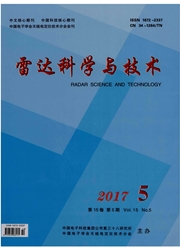

 中文摘要:
中文摘要:
机载前视阵雷达近程杂波谱在方位-多普勒域随距离变化剧烈,功率谱不重合并严重展宽,直接进行空时自适应处理(STAP)不能在待检测单元形成窄而深的凹口,致使地面动目标检测(GMTI)性能下降。文中提出一种导向矢量矩阵最小二乘拟合方法,该方法利用训练单元和近程待检测单元导向矢量拟合矩阵对杂波数据进行变换,使训练单元的杂波子空间逼近于待检测距离单元,从而实现了机载前视阵雷达近程杂波谱重合。仿真实验表明该方法能够对近程杂波非均匀性进行有效补偿,减轻杂波谱随距离变化对空时自适应处理性能的影响。
 英文摘要:
英文摘要:
In angular and Doppler domain, clutter spectrum from short ranges for airborne forward-look- ing radar varies sharply and widens with range bins, thus leading to wide and low clutter notch and undesira- ble performance of ground moving target indication(GMTI) in space-time adaptive processing(STAP). In this paper, we present a method of steering vector matrix fitting via the least square principle. The clutter subspace on the range bin to be detectioned can be approximated by transforming the training data via a series of fitting matrixs. These matrixs can be obtained by converting the steering vector of the training ranges into the range bin to be detected. Results from experiments show that the proposed method can mitigate the range-dependence effectively.
 同期刊论文项目
同期刊论文项目
 同项目期刊论文
同项目期刊论文
 Performance improvement for monostatic clutter mitigation using space-time-range three dimensional a
Performance improvement for monostatic clutter mitigation using space-time-range three dimensional a Unambiguous Doppler centroid estimation approach for SAR data based upon compressed signal magnitude
Unambiguous Doppler centroid estimation approach for SAR data based upon compressed signal magnitude 期刊信息
期刊信息
